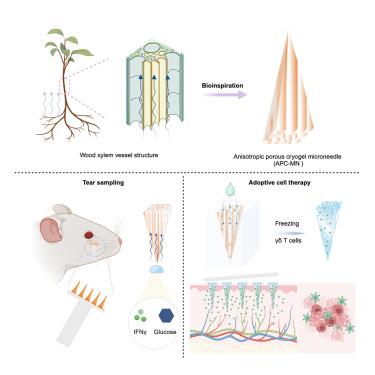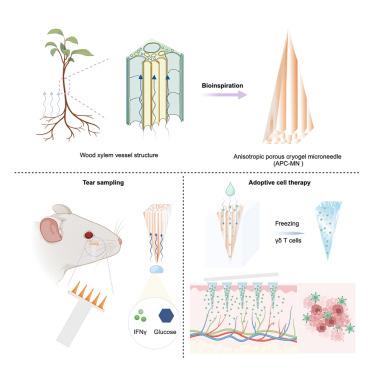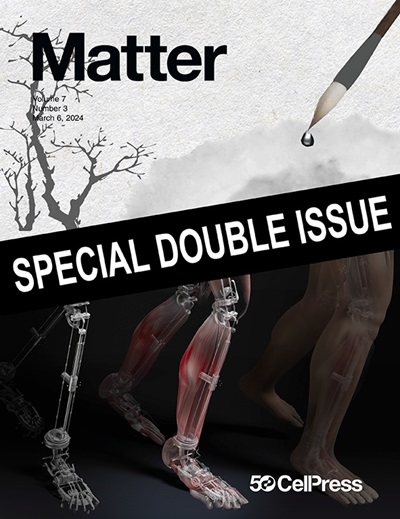微针具有各向异性多孔微观结构,有利于小分子、脂质纳米颗粒和T细胞的透皮递送
IF 17.5
1区 材料科学
Q1 MATERIALS SCIENCE, MULTIDISCIPLINARY
引用次数: 0
摘要
多孔微针(MNs)为药物输送和生物流体取样提供了最佳性能。然而,目前的多孔纳米颗粒存在随机连接的孔隙,现有的制造方法缺乏对孔径和方向的控制。受木材木质部各向异性多孔结构的启发,本研究采用冷冻铸造技术来精确控制MNs中的这些参数。这种特殊的微结构使液体在几秒钟内从尖端快速吸收到底部,使其成为监测泪液生物标志物的有效泪液取样工具——在干眼病和糖尿病的大鼠模型中证实了这一能力。此外,这些各向异性多孔MNs促进了各种药物(包括γδ T细胞)从底部到尖端的主动负载,而无需专门的设备。通过MNs传递γδ T细胞已显示出对异种移植黑色素瘤和胸膜间皮瘤小鼠模型的肿瘤有效,为过继细胞治疗提供了一种新的方法。本文章由计算机程序翻译,如有差异,请以英文原文为准。


Microneedles with an anisotropic porous microstructure facilitate the transdermal delivery of small molecules, lipid nanoparticles, and T cells
Porous microneedles (MNs) offer optimal performance for drug delivery and biofluid sampling. However, current porous MNs suffer from randomly interconnected pores, and existing fabrication methods lack control over pore diameter and orientation. This study employs a freeze-casting technique to precisely control these parameters in MNs, inspired by the anisotropic porous structure of wood xylem. This specialized microstructure enables rapid liquid absorption from the tips to the base within seconds, making it an effective tear-sampling tool to monitor tear biomarkers—a capability confirmed in rat models of dry-eye disease and diabetes. Additionally, these anisotropic porous MNs facilitate the active loading of various drugs, including γδ T cells, from the base to the tips without the need for specialized equipment. The delivery of γδ T cells via MNs has shown efficacy against tumors in both xenograft melanoma and pleural mesothelioma mouse models, presenting a novel approach to adoptive cell therapy.
求助全文
通过发布文献求助,成功后即可免费获取论文全文。
去求助
来源期刊

Matter
MATERIALS SCIENCE, MULTIDISCIPLINARY-
CiteScore
26.30
自引率
2.60%
发文量
367
期刊介绍:
Matter, a monthly journal affiliated with Cell, spans the broad field of materials science from nano to macro levels,covering fundamentals to applications. Embracing groundbreaking technologies,it includes full-length research articles,reviews, perspectives,previews, opinions, personnel stories, and general editorial content.
Matter aims to be the primary resource for researchers in academia and industry, inspiring the next generation of materials scientists.
 求助内容:
求助内容: 应助结果提醒方式:
应助结果提醒方式:


